Bremen, a Surprising Brothers Grimm’s Fairy-Tale
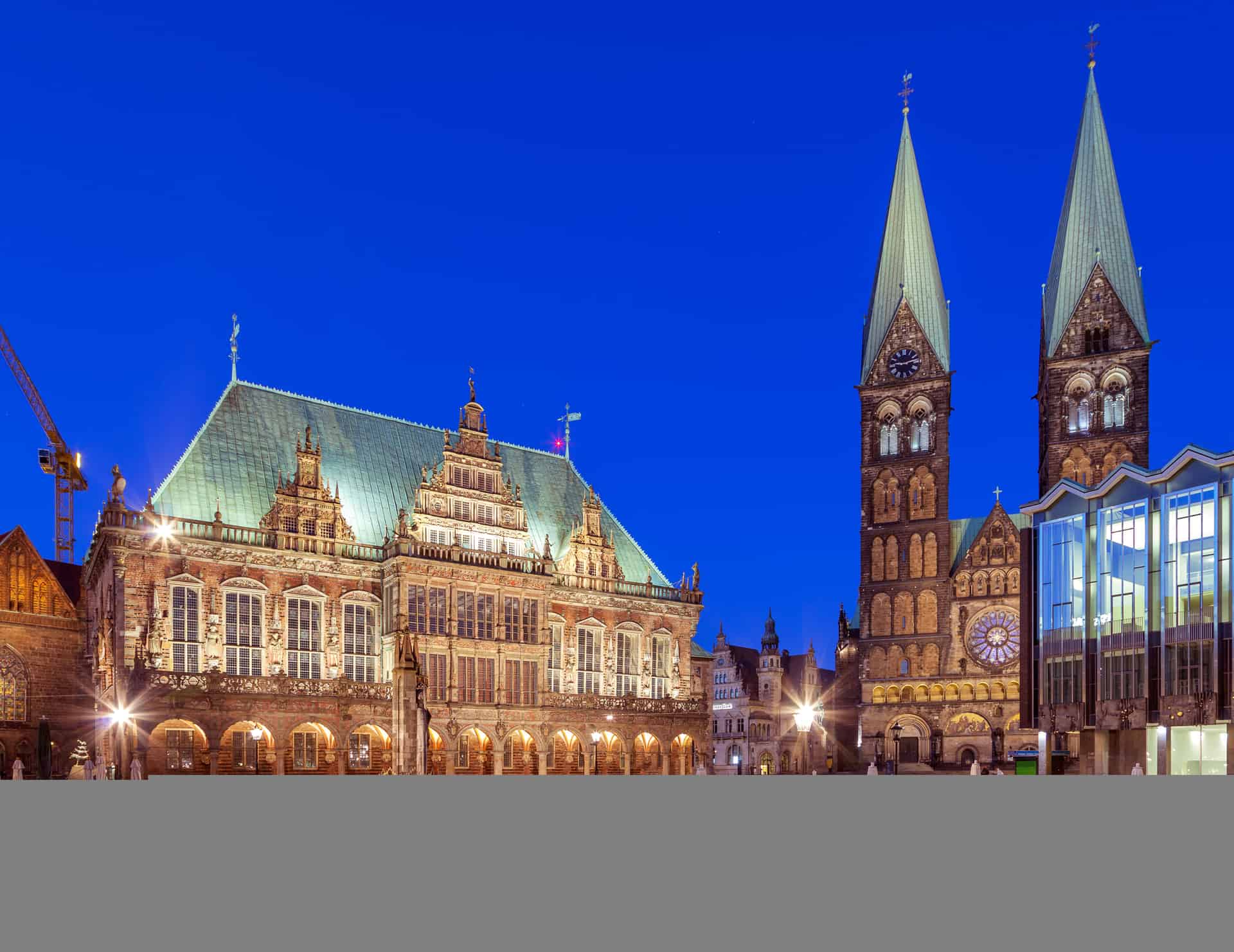
Updated On: November 08, 2023 by Aya Radwan
Located on the line of the longest river flowing through Germany; the Weser, Bremen is the capital of a two-city state in Germany called the Free Hanseatic City of Bremen.
The city of Bremen, officially referred to as the City Municipality of Bremen, is the largest city on the banks of the River Weser. The city is the fourth largest city in the low German dialect area.
With the second largest port in Germany after that of Hamburg, and the 12th busiest airport in the country, Bremen is a bit cultural and economic hub. This working-class city is famous for housing dozens of historical galleries and museums with many multinational companies and manufacturing centers.
Ever heard of “Town Musicians of Bremen”? The Brothers Grimm fairy tale? Well, you’ve guessed it right, most people know the city of Bremen through that famous fairy tale, there’s even a statue in front of the city hall dedicated to it.
With a moderate oceanic weather, a mild summer and cool winter is what you’d expect in this city.
July and August constitute the peak of the tourist season. Since rain-fall is evenly distributed around the year, the May – June and September – October seasons are also great for a visit. The home of the most delicious chocolate brand; Hachez, welcomes you in whichever season you choose for your visit.
In this article we’ll learn how to get to this interesting city, what places you can visit around and the various festivities you can attend to soak up its unique atmosphere.
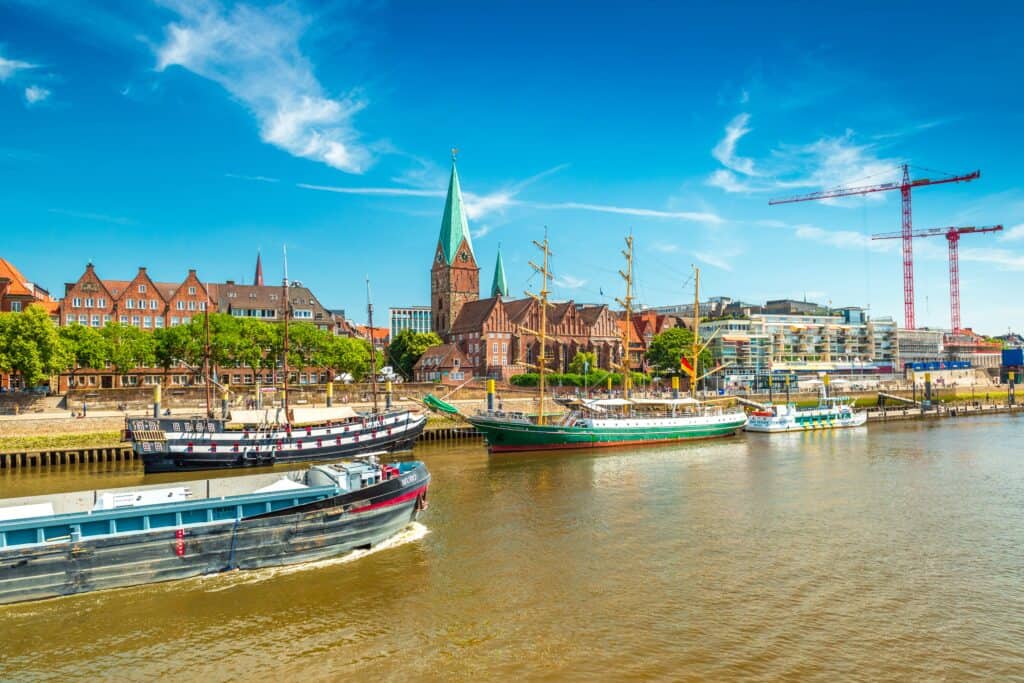
How to get to Bremen?
- By flight:
The airport of Bremen – Flughafen Bremen – is about 3.5 Kilometers south of the city and handles flights to various European countries. There are flights from and to the city through many renowned airlines, at which you can get great prices if you book in advance.
Ryanair for example operates flights to London and Mallorca in Spain, KLM; the Royal Dutch Airlines operates to and from Amsterdam. Other seasonal flights are via Turkish Airlines coming from Istanbul or using Sundair coming from Beirut.
A roundtrip flight from London Stansted Airport to Bremen Airport, booked a month in advance will cost about 75 Euros and the duration of the flight is less than an hour and a half either way. It’s worth noting that the day you book your flight, traveling out or return, affects the price greatly.
There’s no direct flight from Berlin to Bremen, only a transit flight that goes through Stuttgart first. It’s also wise to understand that flying in to Bremen is most suitable if time is of the essence and you’d like to get there faster.
- By train:
Bremen S-Bahn; the city’s main railway station, has been in operation since 1847. A train ticket from Berlin Central Station to Bremen Central station, booked about a week in advance will cost about 42 Euros. The website Bahn.de will help you with not only ticket prices but also all other important travel information.
If you’re coming from across the English Channel, a train ticket’s price will start from 166 Euros. The train will get you there in a less than 8 hours and a half.
- By bus:
The cheapest alternative to flying from Berlin is the bus ticket. At a cost of 16 Euros, the bus will take you to Bremen in a bit over 5 and a half hours. This is not a recommend means of transportation if you’re coming from a farther place such as London.
On the other hand, a night bus from Brussels will get you to Bremen in 6 hours and a half for a ticket of 24 Euros. A good website for booking bus tickets is Getbybus.
Historical Landmarks in Bremen
Now that I have you in Bremen, welcome! There are many historical sites you can visit in the city, I promise you this won’t be overwhelming and your visit will be as enjoyable as you want it to be. So, let’s get to it!
- Petri Dom zu Bremen (Saint Peter’s Cathedral of Bremen or Bremen Cathedral):
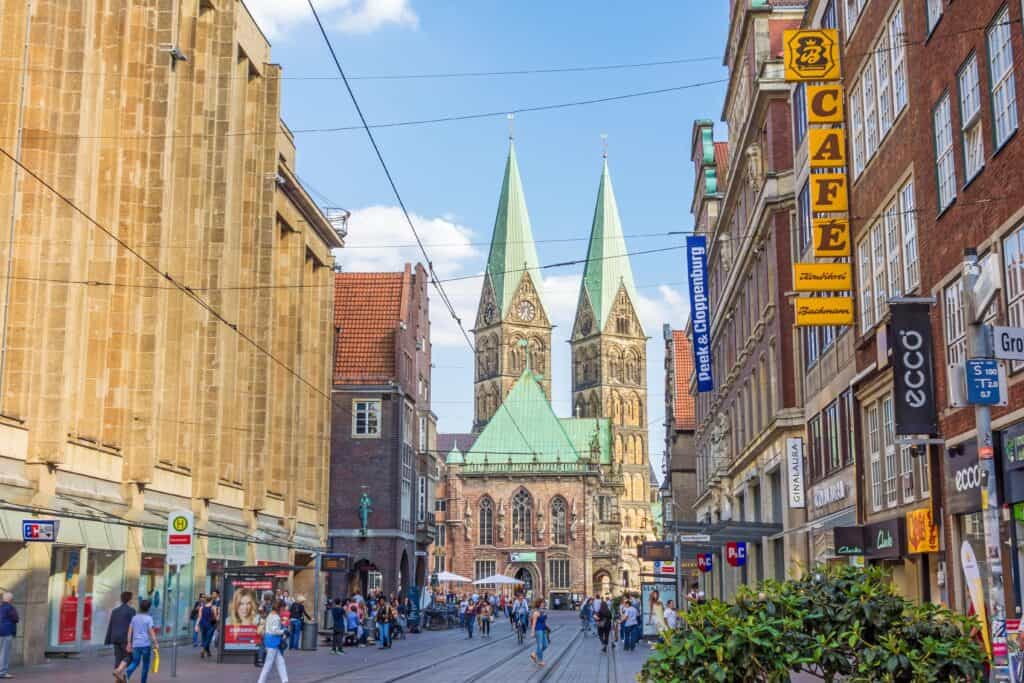
This medieval style cathedral is located at the heart of Bremen, east of the Marktplatz. The earliest church traced in the same location goes back to 789 which was a timber church on a high point. This church was burnt down along with most of Bremen when the Saxons came.
The construction of a new church began in 805 using sandstone after site’s been empty for 13 years. All rebuilding and renovation efforts of the building went to waste due to a huge fire the devoured the church and its library, along with most of Bremen, in 1041.
The new building of the cathedral began in 1042 using a Romanesque style. The person responsible for the rebuid; Archbishop Adalbert, commissioned craftsmen from Lombardy, Italy, to embellish the cathedral which he drew inspiration for from Italian basilicas.
The easy destruction of the cathedral by the Saxons, again, in 1064 was due to Adalbert’s short-sightedness.
Restoration works began afterwards but were interrupted several times. The direction of architecture though drifted from Romanesque to Gothic up to 1911.
The Gothic style of the basilica is emphasized more by adding a new northern nave and more chapels. This gave the church a more German “High Gothic” look.
In two unfortunate accidents, the southern belfry collapsed in 1638 causing damage to the surrounding buildings and killing 8 people. In 1660, lightning struck the norther tower and burned the roof.
The southern roof suffered a second collapse after which it remained an open ruin for over two centuries.
The church’s renovation went underway in the 1880s with medieval inspiration and the walls were repainted in a neo-Byzantine style and the church finally reopened in 1901.
Again the church suffered damage during the Second World War, for fear of the collapse of the entire building, all windows and roofs were closed soon afterwards and by 1950, the vaults were reconstructed and the building stabilized again.
The next restoration works took place between 1972 and 1981 during which many of the neo-Byzantine paintings disappeared but many stained glass windows were made. Since 1973, it is protected by the monument protection act.
- Katharinen-Kloster (Saint Cathrine’s Monastery):
The once brick Gothic building was built in 1253 by the Dominicans. During its lifetime, the church served many purposes. Once a grammar school, a library, an arsenal, a historical museum and a storehouse.
The monastery was demolished in 1960 after suffering damage during the Second World War. Traces of the building can be seen now in the areas of the Katharinenstraße and Katharinenklosterhof in the old town.
- Kirche Unser Lieben Frauen (Church of Our Lady):
Listed under the monument protection act, this is the oldest church in Bremen. Even though the church’s current building dates back to the 13th century, the church itself goes back to the 11th century.
The church was originally dedicated to Saint Vitus. It served as a market church of the city and later as church of the city council.
In 1020, a new building decorated with medieval frescos was built. In the middle of the 12th century, the church was extended to form a basilica.
The church was consecrated to the Virgin Mary in around 1220 after which the church was rebuilt in the early Gothic style as a hall church starting from 1230.
- Martinikirche (Saint Martin’s Church):
One of the oldest churches in the city, it is located in the old town near the Weser river. The church was founded in 1229 in late Gothic style. However, the building sustained damages during the Second World War and was rebuilt afterwards in 1960. The church was listed under the monument protection act in 1973.
- Bremen City Hall (Bremer Rathaus):
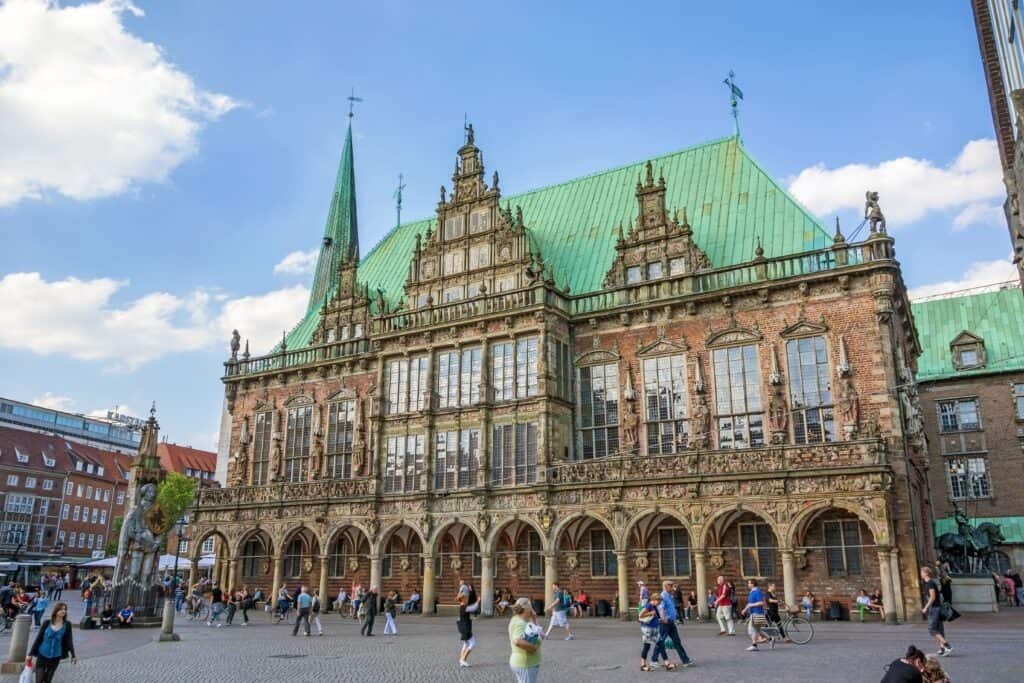
As one of the most important examples of Brick Gothic and Weser Renaissance architecture, the city hall has earned both the protection of the monument protection act in 1973 and the status of a UNESCO World Heritage Site in 2004.
The city hall is on the northeastern side of the market square in the historic city center, it is the seat of the President of the Senate and Mayor of the Free Hanseatic City of Bremen.
The building underwent many style changes, presumably having a Romanesque style at the beginning and once served as a law court. The building was once hired to the grocers’ guild, once it was a hobs store and later sold to two owners who converted it to their own residences.
A new town hall was built around 1400, this time in Gothic style decorated with 16 large sculptures showing emperors, prince-electors and four ancient philosophers.
During the Renaissance period, the town hall was developed again by converting the ten windows of the upper hall from pointed arches to large rectangular windows. About 12 years later, the two middling windows and the proclamation door between them were replaced by slim pillars and columns and large windows.
In the 19th century, the archbishop’s house beside the town hall was taken down and rebuilt as the neo-Classical Stadthaus (Municipal Office Building). In the 20th century though, the Stadthaus was dismantled to build the new town hall.
In the period from 1909 to 1913 the town hall was extended twice as big as the old one. Despite the severe damage the city of Bremen suffered during the Second World War, the town hall suffered little damage.
The Town Hall’s main sights included in the Old Town Hall are The Upper Hall, the Golden Chamber, the Lower Hall and the Bremer Ratskeller. In the New Town Hall there’s the Banquet Hall, the Fireplace Room, the Gobelin Room and the Senate Hall.
- Bremen Roland:
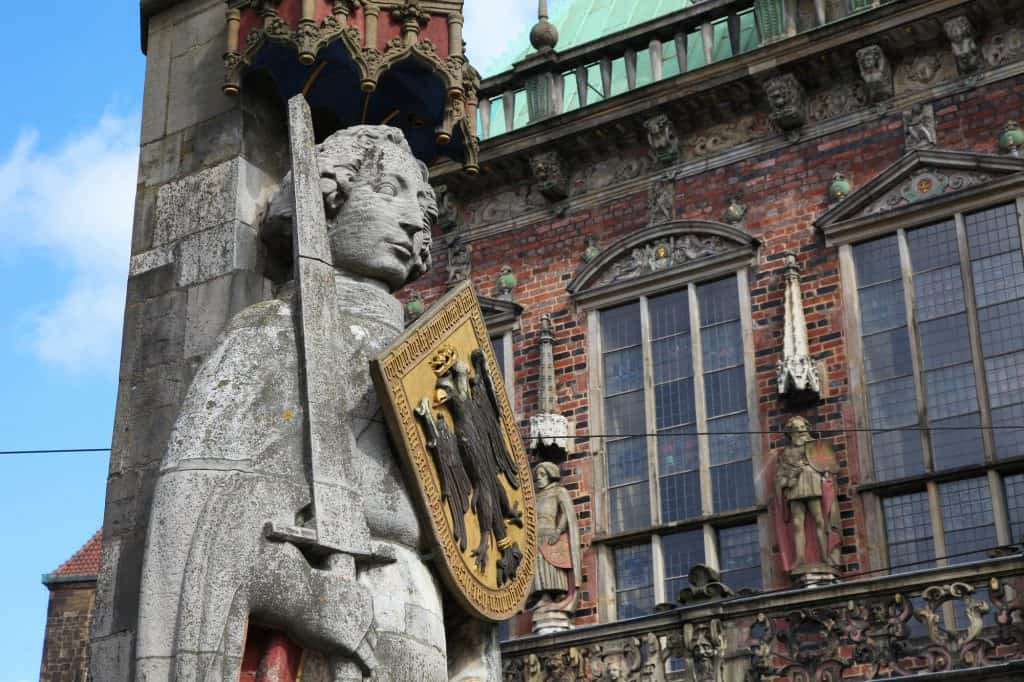
Part of the Bremen Town Hall, the statue was built in 1404 and it faces the cathedral. The statue is of Roland, paladin of the First Holy Roman Emperor Charlemagne. He is depicted as protector of the city with his drawn sword and his shield is emblazoned with the two-headed Imperial eagle.
Legend says that the city of Bremen shall remain free for as long as Roland stands protecting it, which is why it’s alleged there’s a second statue hidden in the town hall’s underground vaults, just to be safe!
- Bremer Marktplatz (Bremen Market Square):
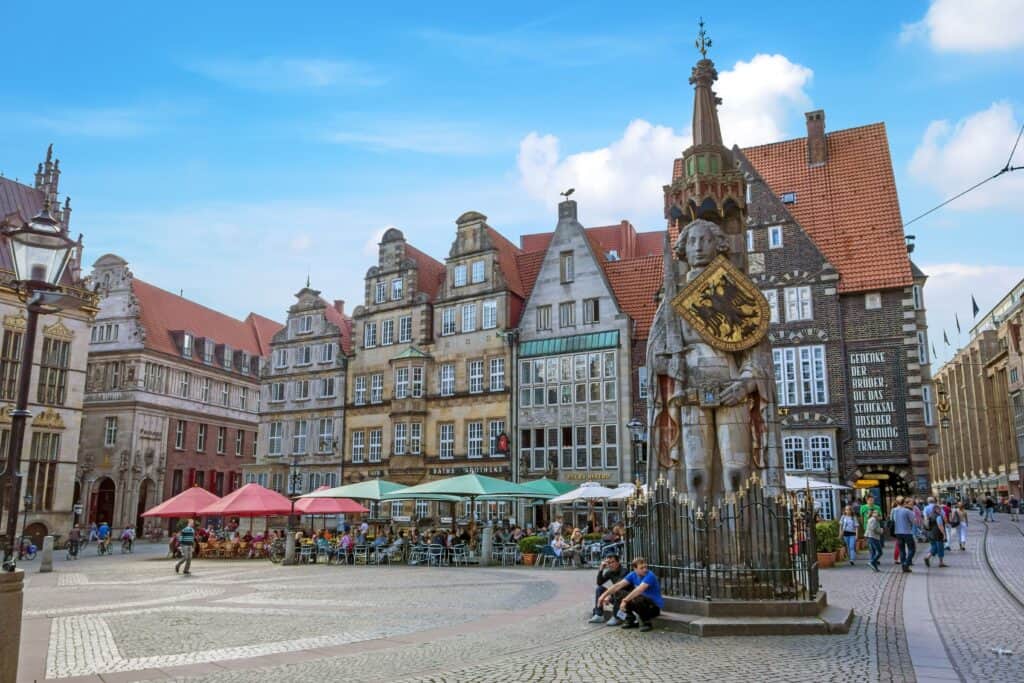
One of the oldest squares in the city, it’s no longer used as a market place except for the Christmas Market and the annual Freimarkt Fair at the end of October.
There used to be a stone wall between the inner and the outer areas of the square. Later in the end of the 18th century or beginning of the 19th century, the wall was replaced by a circle of columns.
The funniest thing regarding the square when it still acted as a market was that the city council allowed only merchants with cars that could pass through one of the seven openings in the wall to enter the market to sell their goods.
This rule was put to ensure there was enough room for pedestrians between the market stalls.
- Town Musicians of Bremen:
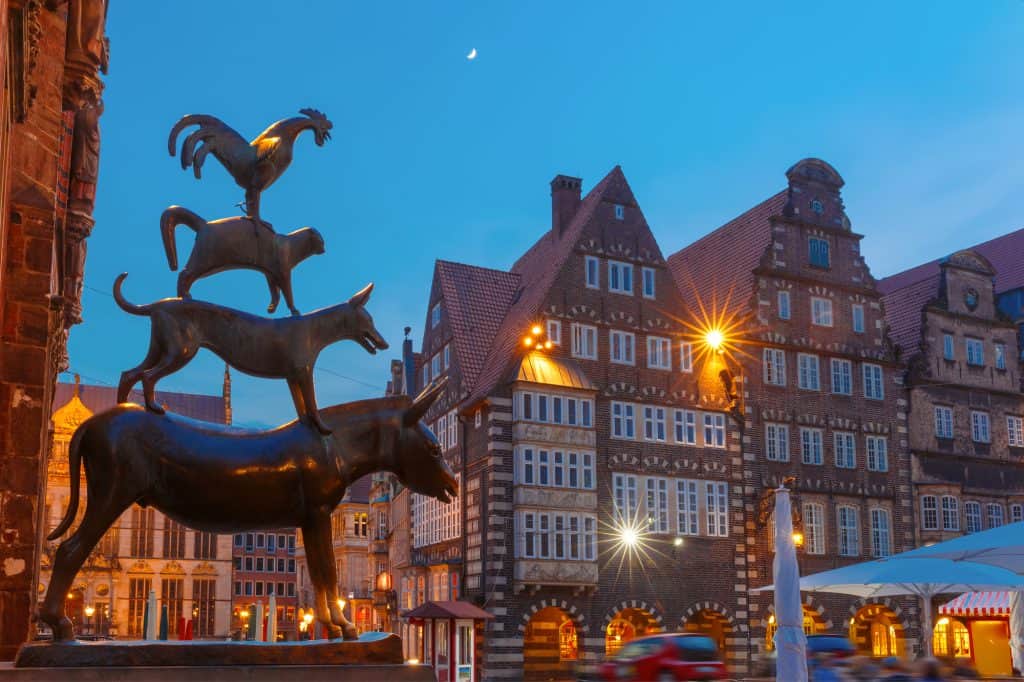
This popular German fairy tale was told by the Brothers Grimm in 1819, based on the account of the German storyteller Dorothea Viehmann. The story tells of four aging domestic animals; a donkey, a dog, a cat and a rooster.
After a lifetime of hard work the animals were neglected and mistreated by their former masters. The animals then decide to run away to the city of Bremen and become musicians.
Even though the name of the statue and the fairy tale element suggest that the animals made it to the city and fulfilled their dream.
They never actually made it to the city, instead they trick and scare off a band of robbers and end up taking their belongings and moving into their house. The tale has been retold through animated pictures, motion pictures (often musicals), theatre plays and operas.
- The Schütting:
Located on the Marktplatz, this building initially served as the guild house for the city’s merchants and tradesmen. The building has been under monument protection since 1973.
An interesting fact for coffee lovers, the first coffee house in German speaking countries was established in Bremen in 1673 and even-though its exact location is unknown, it’s been located at the Schütting since 1679. In the basement of The Schütting is the rooms of “Club zu Bremen” which is a traditional gentleman’s club. The club has been open for female members since 2000.
- Rathscafé (Town Council Café):
This listed building in the Marktplatz is now named Deutsches Haus. Both the building on the site and the site itself were used for several purposes throughout history. The Rathscafé was supposedly built between 1909 and 1911 and it was destroyed during the Second World War.
The building was sold after World War II and was rebuilt and given its current name Deutsches Haus. The building received monument protection in 1973.
- Raths-Apotheke (Council Apothecary):
This building on the Marktplatz came under the Monument Act in 1973. There’s been a Raths-Apotheke in Bremen since 1510. From 1594 to 1820, the apothecary was located in two beautiful three-story gabled buildings that stood at the current location of the apothecary.
The new building of the apothecary was completed in 1894, after much public debate, in order to maintain the appearance of the endeared Marktplatz. After suffering some damage during the Second World War, the building’s restoration only finished in 1958.
- Haus der Stadtsparkasse:
This Rococo building was completed in the 1950s and was listed under the Monument Act in 1973. The building was once used as an Inn in 1836. Today, the building houses a branch office of the Sparkasse, a municipal savings bank.
- The Stadtwaage:
Once the home of the municipal weighing scales, it was created to levy taxes and excise duties while protecting both merchants and customers from fraud and dishonesty. A mention of a weigh house in historical documents goes back to 1330.
Today, the building is used as a cultural center. It contains rooms for presentations, exhibitions and receptions.
- Böttcherstraße:
This street, in the historic center of Bremen is famous for its unusual architecture since most of its buildings were erected between 1922 and 1931. A coffee trader by the name of Ludwig Roselis commissioned local artists to transform the street using a mixture of Gothic and Art Nouveau.
The Böttcherstraße was an important link between the market square and river Weser in the Middle Ages and was traditionally inhabited by coopers. When the harbor was relocated in the mid-19th century, the Böttcherstraße began to lose its importance.
In 1902, it was said that Ludwig Roselis bought the house at 6 Böttcherstraße and made it the headquarters of his company which would later produce the HAG coffee brand.
In the following years, he bought several buildings around the place as well and many other houses were constructed as well using the typical materials at that time: brick and sandstone.
In 1926, contrary to the appearance of most of the buildings on the street, Roselis had the Paula Modersohn-Becker-Haus built which is a museum dedicated to the painter Paula Modersohn-Becker. The building’s external walls have relief-like decorations while its internal rooms follow principles of organic architecture.
In 1944, during the Second World War, large portions of the Böttcherstraße were destroyed. By 1954 though, the Kaffee HAG Company had restored most of the façades to their original state.
In 1979, Ludwig Roselius Jr. sold the Kaffee HAG Company, along with Böttcherstraße, to General Foods. Two years later, he bought Böttcherstraße back.
Since then, it has been privately owned. Significant damages to the building fabric became visible in 1989 and the Sparkasse Bremen bank bought the entire street with all its buildings except for Haus Atlantis.
Restoration works were completed in 1999. In present day, the street is managed by Böttcherstraße GmbH of the Stiftung Bremer Sparer Dank foundation.
Today, Böttcherstraße is one of the major tourist attractions of Bremen since it contains several art musuems, arts and crafts workshops, restaurants, shops and a hotel. The entire street has been under the protection of the Monument Protection Act since 1973.
- Glockenspiel House:
This distinguished building is home to 30 bells of Meissen porcelain. The carillon chimes three times a day while wooden panels depicting pioneering seafarers and aviators appear on a rotating mechanism inside the tower.
The bells chime for about 8 minutes and a half. The Glockenspiel is located on the famous Böttcherstraße, it’s considered one of the most important landmarks on that street.
On the site of the building were two old warehouses that were converted into a new office building for the Bremen America Bank in 1922. The façades were built in Neo-Renaissance style and the carillon of 30 Meissner porcelain bells lodged between the gables were added in 1934 maintaining a medieval tradition.
At first, the bells were painted blue on the outside and gold on the inside. When the carillon chimed, 10 colored wooden panels came into view as they rotated inside the tower.
After the building suffered serious fire damage during the Second World War, the carillon was replaced but with white porcelain bells. The panels were restored in 1991 and the carillon as well, which received a new set of white bells.
In 1937, the National Socialist Party listed Böttcherstraße for cultural heritage protection as an example of degenerate art.
- Schnoor:
A neighborhood in the medieval center of Bremen, it is the only part of it that kept its medieval character to this day. The neighborhood’s name comes from old handicrafts that are related to shipping and alleys in it are named accordingly.
The Schnoor was one of the poorer corners and developed in the 10th century as a district of fishermen. During its first centuries, the neighborhood was prone to floods since the inhabitants built their homes as cottages on the little island between the rivers Weser and Balge.
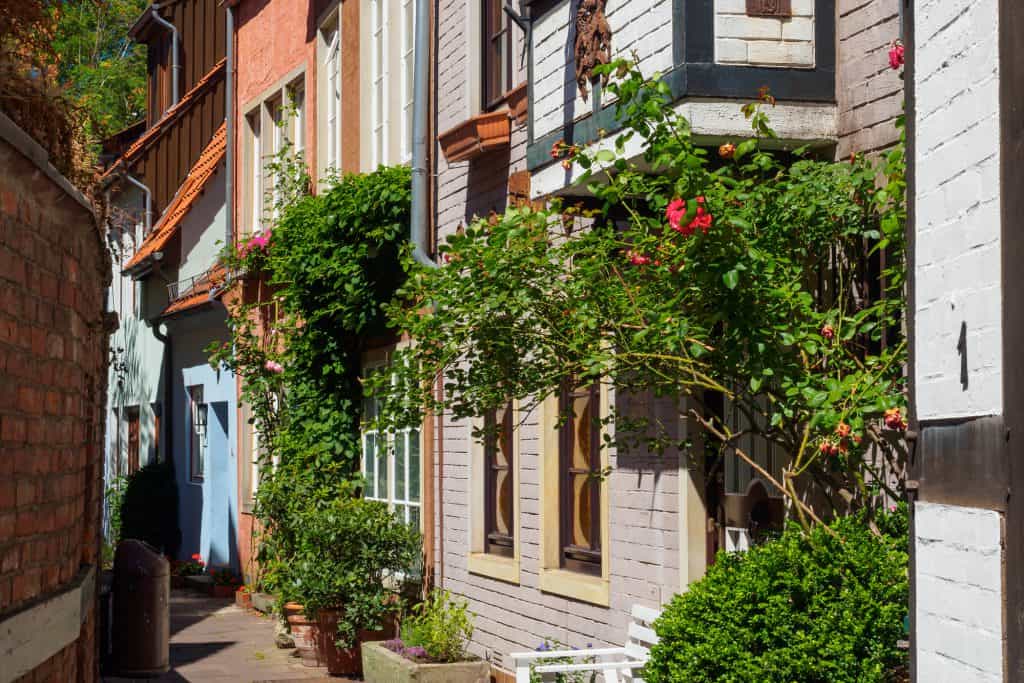
The first ferry service was established there and the first bridge crossing the Weser was built around 1240. The oldest houses in the neighborhood go back to the 15th century while most of the buildings are from the 17th and 18th centuries.
The neighborhood became one of the poorest during the 19th century which meant renovations were unaffordable by the residents. By the mid-1950s the houses were in a rough state.
In 1959, the Senate of the Free Hanseatic Town of Bremen decided to rebuild the historic area of the Schnoor. Residents were motivated by motivated by financial support from the State of Bremen to renovate their houses.
After the Venice Charter for the Conservation and Restoration of Monuments and Sites issued in 1964, the Schnoor obtained historic district status under official heritage conservation through the State Monument Authority.
- Schifferhaus (Shipper’s House in Bremen):
This house is one of the houses that was preserved in its original state in the Schnoor neighborhood. Registered as a historical monument in 1973 along with the rest of the neighborhood.
It’s been a private museum for the past 25 years of the 20th century. The house was built in 1630 and was extended in 1750 and around 1920 as well.
The original truss is well preserved and it’s alleged some of the beams are 400 years old. The house was used for many purposes across history. It was used as an inn with a restaurant on the ground floor and accommodation on the upper floors.
Once an office for business supplies, groceries and food products, turned into a private museum by Theodor Dahle on the ground floor but expanded it to the upper floors in 1975.
Dahle converted the ground floor in a reproduction of a historic restaurant. The museum stayed largely preserved until 2005. The upper rooms were unchanged since Theodor’s wife died.
The owner of the internet shop once opened there had set up a virtual museum to show the history of the house. Public visits to the museum take place on European Heritage Days and other events.
- Landherrnamt:
Designed in Neo-Romanesque style and finished in 1856, this historic building is located in the historic Schnoor neighborhood. The building was designed by Bremen’s planning director; Alexander Schröder who planned several other buildings in the city, with a style of Neoclassism and Romanesque Revival architecture.
The building had many uses over time. From housing the offices of the Landherrn who administered the State of Bremen since 1850.
It accommodated the police and administrative services until the end of the Second World War. After which it was used as a welfare center for the severely injured.
In 1964, the Catholic Church took over the building as a nunnery but later used it to hold classes from the St. Johannis School. Major repairs were carried out in 2011 to improve conditions for the schoolchildren.
Renovation works were carried out on the 150 years old façade where the former pink color was removed to show the true color of the sandstone.
- Birgittenkloster (Convent of Saint Birgitta):
Founded in 2002, this convent is the first to be founded in Bremen since the Reformation. The idea was originally born in 1998 the Deanery Pastoral Conference and it was built in the Schnoor neighborhood of the city, on the site of a former bakery.
There’s a chapel and living quarters, there’s a guest house with 12 rooms. There are seven nuns in the house who take care of the guests and prepare their meals. The 12 rooms can accommodate 18 guests and the convent welcomes both individuals and groups who want to escape from the hustle of everyday life.
- Johann (St. John’s Church):
This Roman Catholic Church was built in the 14th century in Schnoor and was listed as a historic monument in 1973. A church with a basilica was built in 1225, later was expanded in 1380.
In 1528, during the Reformation, the church was closed and Bremen’s first hospital and mental asylum was built on the site in 1538 with the approval of the monks.
The church continued to serve as Bremen’s hospital until the middle of the 17th century except that at the time it became a retirement home. In 1802, only the choir was used in religious services. The Catholic community acquired and rebuilt the church in 1806.
In 1834, using the rubble from the destruction of the monastery for hygiene reasons, the level of the streets around the church was raised by two meters to avoid floods. The floor level of the church was raised afterwards by three meters which created a large cellar, now became the crypt.
St. John is the only surviving monastery church in Bremen. Only Catherine’s Passage in the city center testifies to the existence of the earlier Dominican monastery and its church of St. Kathrine. St. Paul’s monastery in front of the city gates was destroyed in 1546.
- Bismarck monument:
This bronze figure built in 1904 outside the cathedral in Bremen shows the former Chancellor Otto von Bismarck riding a horse. Bismarck was celebrated as the iron chancellor, above all because of the integral part he played in creating the German State.
Even though Bismarck’s relationship with Bremen’s political establishment wasn’t always a smooth one, he was still revered both in Bremen and in many parts of the new established state that were not a part of Prussia.
The significance of this monument of Bismarck is that it’s the only one taking the form of an equestrian statue. The chancellor sits on a horse at the top of a six meter tall stone plinth, wearing a helmet a slightly stylised version of the uniform of the Cuirassier regiment.
The horse’s head is half turned towards the cathedral square which gives a hint of liveliness. The chancellor holds a scroll in his right hand which has been interpreted as a constitutional document.
- Essighaus:
This impressive gabled house was almost completely destroyed by bombing in 1943. It’s considered one of Bremen’s finest examples of Renaissance architecture.
The house was built in the ornate Renaissance style in 1618. Its richly decorated façade and interior created a reputation for it way beyond the borders of the city. The building combined living quarters, an office and a shop, it was typical of Bremen’s old merchants’ houses.
Essighaus was the location of a fainting spell by Sigmund Freud in 1909. His student Carl Jung saw this incident as an evidence of the psychoanalyst’s own neurosis.
After suffering from damage during the Second World War, the house was rebuilt but only the lower façade was restored from the remains.
The building now belongs to Deutsche Factoring Bank since 1985 where a plaque on the building tells its history and the history of the grander Kornhaus which once stood next door before getting razed by the war.
The Essighaus has been a heritage monument since 1973.
- The Schlachte:
Once one of Bremen’s harbors, this promenade along the east bank of the river Weser is now known for its restaurants, beer gardens and river boats. The Schlachte along with the Balge were both used as harbors for wood and limestone.
The Schlachte was Bremen’s main harbor until the beginning of the 19th century. When the railway arrived in 1860 it resulted in major changes to Bremen’s harbors especially after Bremerhaven was connected to the rail network in 1862.
After that The Schlachte played no role as a port for the city. A complete transformation was carried out of the area at the end of the 20th century.
Offices and storerooms that were abandoned for decades were renovated. The Schlachte was extended both upstream and downstream to create a modern promenade connected to paths leading into the old town.
Today, the Schlachte is a place where you can have great food from restaurants on land or the ones in the docked ships. There are also hotel ships, a youth hostel and during the summer months there are many festivals including a regatta, flea markets and a barbecue festival.
- Viertel:
The name literally means “quarter”, this neighborhood in the east of the old town of Bremen is packed with cafés, restaurants and boutique shops. The neighborhood was originally developed between the mid-19th century and the 1930s.
In the mid-20th century, the buildings were in a rough state and were almost given up upon until 1973 when the façades were restored.
The neighborhood became one of Bremen’s most lively and presentable neighborhoods. New Buildings were built in the same style and color to match those of the old buildings.
From lounging at the cafés in the neighborhood, grabbing a bite, you must visit the boutique shops which offer everything you can imagine.
The Viertel is home to many landmarks including the city’s main theater; Theater am Goetheplatz, the art museum; Kunsthalle Bremen and the Gerhard Marcks House museum.
Museums and Parks in Bremen
Bremen might be rich in architectural buildings of all styles and eras, but the city also presents you with a variety of museums and parks that will satisfy both, the art lover you are and the child inside you.
- Universum Bremen (Universum Sceince Center):
Opened in September 2000, this science museum encourages visitors to interact with more than 250 exhibits. The topics of the exhibitions are divided between mankind, earth and cosmos.
The unique building resembles a mixture between a whale and a mussel. In 2007, the Universum opened a new building in the shape of a cube called the SchauBox and is used for additional exhibitions which change annually.
A park zone was also created; the EntdeckerPark which hosts a number of hands-on-exhibits and landscape elements.
- Kunsthalle Bremen:
This art museum in the Viertel neighborhood was built in 1849 and was listed as a historic monument since 1977. The building was expanded in 1902 while the façade was still under construction until 1904.
When the Second World War broke out, the collections from the museum were moved to different places to ensure their safety.
The paintings, drawings and graphic sheets were divided between Karnzow Castle of Count Königsmarck near Kyritz, Neumühle Castle of Count von der Schulenburg in Salzwedel, and Schwöbber Castle near Hameln.
The sculptures were taken to the princely crypt at Bückeburg Castle. Karnzow Castle held 50 paintings, 1,715 drawings about 3,000 prints from the collection.
When the Soviet took the castle on their way home, the place was destroyed which left the vault room open; making these priceless treasures in the reach of everyone. It was estimated that over 1,500 works from the Kunsthalle are still missing till today.
It was not until 1961 that a complete restoration work of the museum took place and the place was entirely open for art exhibitions. Followed by an extension in 1982 and renovation works between 1990 and 1999. The most recent renovations were between 2009 and 2011.
The museum houses a collection of European paintings from the 14th century to the present day, sculptures from the 16th to the 21st centuries and a New Media collection.
- Gerhard Marcks Haus (Gerhard Marcks House):
This museum is inspired by the works of the sculptor and graphic artist Gerhard Marcks and is located in the Viertel neighborhood. The Gerhard Marcks Museum’s building and Wilhelm Wagenfeld House were built as a pair in 1825.
The two buildings were built to be a gatehouse and a prison on either side of the road. Until 1848, both houses were used to close the city at night and charge any customs tax that was due on good.
The buildings were expanded to fit their new roles as museums in 1991. The two buildings have one row of windows at the front, they both have two floors and matching Doric columns.
The Gerhard Marcks Museum shows contemporary sculptures beside the works of Marcks. Of his works the museum holds 400 sculptures, over 1,200 prints and 12,000 of his drawings. The museum holds both regular and temporary exhibitions of famous and aspiring artists.
- Wilhelm-Wagenfeld-Haus (Wilhelm Wagenfeld House):
This design museum and art exhibition is located in the Viertel neighborhood, opposite Gerhard Marcks Haus. It was built in 1828 with a Neoclassical style, the building currently carries the name of the Bremen born Wilhelm Wagenfeld.
He was an important industrial designer and a major contributor to the 20th century design of household objects.
In collaboration with the Wilhelm Wagenfeld Foundation, Bremer Design GmbH uses the exhibition center to promote the creative industries which are so important to Bremen’s development.
The cooperation creates the opportunity to benefit from international successes while also proudly displaying the major results by local enterprises.
- Wilhelm Holtorf Kolonialwaren:
Another listed building in the Viertel neighborhood is this old grocer’s shop that’s been there since 1874. The deli is considered to be Germany’s last grocery store.
In 1903, the building was replaced by a new one consisting of four floors instead of two, it’s the one still standing today. The historic art Nouveau shop furnishings in oak from 1910 have been preserved until today.
The Schwiering family continued the work after Holtorf – who bequeathed the building to them – followed by the Bremen agricultural engineer Marcus Wewer until the Oldenburg Company Heimathaven took over the building in 2017 and renamed it Holtorfs Heimathaven. Nowadays, delicacies and delicacies from selected manufacturers are sold.
- Übersee Museum Bremen (Overseas Museum):
Protected by the Monument Protection Act, this is a natural history and ethnographic museum. It’s an integrated exhibition of Nature, Culture and Trading relating to overseas regions. There are permanent exhibitions represent Asia, The Americas, Africa and South Pacific/ Oceania. In 1875, the collections of the Bremen Natural History Society became the property of the city of Bremen.
- Focke Museum:
Formed in 1924 through a merge between museum of industry and commerce and the previous historical museum, this is the museum of history and the history of art of the city of Bremen.
The current museum is named after Johann Focke who founded the historical museum. The combined institution of the two museums first opened in 1927 until the museum closed in 1939 with the outbreak of the Second World War.
Even though the collection survived the war; being placed in storage, the building didn’t and the rebuild was a must.
In 1953 the museum reopened in the 18th-century Haus Riensberg and in 1959 the foundation for a new building was laid and opened in 1964. This main building is considered one of Bremen’s most outstanding 20th century buildings.
The museum complex currently includes three other historic buildings, an extension built in 2002 and a park that’s also used for exhibits and events.
The museum also offers special exhibitions on topics relating to the history of Bremen, crafts and design, and photography and other arts. It also holds tours and lectures for different age groups.
- Weserburg:
Is a modern art museum that opened in 1991 and is located in an old factory building that was almost completely destroyed in the Second World War. It was Europe’s first collectors’ museum.
It holds no permanent collection but holds changing exhibitions of private collections. It’s also one of the largest modern art museum spaces in Germany.
- Ludwig Roselius Museum:
Located at Böttcherstraße, this museum showcases Northern European art from the Middle Ages to the Baroque. The building is a town house from the 16th century as the building was built in 1588 in the Renaissance style.
Ludwig Roselius opened the museum in 1928 after he’d bought the building where he displayed his private art collection. During the Second World War the museum was destroyed except for the façade.
The museum was able to reopen after a restoration in 1954. After Ludwig Roselius passed away, not all his works continued to be displayed at the museum as some of them went into private ownership.
The Ludwig Roselis Museum together with the Paula Modersohn-Becker Museum make the Böttcherstraße Museums.
The construction of this museum is credited to Ludwig Roselius, who built it in 1927. It’s the first museum in the world to be dedicated to the works of a female painter. It showcases works from all the creative phases of Paula Modersohn-Becker’s life.
The museum suffered great damage during the Second World War but it was restored and expanded until 1994. The museum shows works from all the creative periods of the artist. Starting from the first pictures from her time in Worpswede.
- The Bürgerpark and the Stadtwald:
The second largest green space in the Hanseatic city, they are the most famous parks in Bremen. The Bürgerpark was created in the second half of the 19th century as a classic public garden, with lakes, coffee houses and lawns.
The building of the forest to the north was finally approved in 1906. Together, the two parks are among the largest city parks in Germany. The parks are fully developed and criss-crossed by a dense network of paths and together include five large lakes
There are several recreational activities’ opportunities in the park such as animal enclosure, boat rentals, natural trails, running trails, mini-golf parks and boules courts.
There are also various sculptures, memorials, busts and monuments in different parts of both parks, some of which are over 130 years old along with several listed buildings in coordinated natural ensemble.
One of the most beautiful features in the park and the forest are the artistically designed benches, almost all of them are based on private donations.
- Knoops Park:
Located in the Burglesum district in Bremen, is named after the Bremen merchant Ludwig Knoops who originally commissioned the park to be set around his castle; the Mühlenthal Castle.
The castle was demolished in 1933 and in 1936, the space became property of the municipality which converted it into a public park.
Along with several other parks, the Knoops Park was listed in the state’s monuments’ list and is owned by the Bremen Landscape Protection Area. An English oak tree that stands in the park is said to be over 250 years old.
- The Rhododendron-Park Bremen:
This free public park in the State of Bremen houses a huge collection of rhododendrons and azaleas as well as a substantial botanical garden. While admission into the park is free, entering the Botanika isn’t.
The Rhododendron Park began in 1933 on the initiative of the German Rhododendron Society on former farmland and forest, it finally opened to the public in 1937.
The botanical garden on the other hand dates back to 1905 when it was created by businessman Franz Schütte at a different site. The original garden was organized geographically, with plants from the Orient, Mexico and Caucasus as well as a collection of crop plants, medicinal herbs, native plants and poisonous plants.
The garden was privately owned until 1935 when it became city property and transferred to its current location in the Rhododendron Park over the next few years. Today’s garden was completed between 1949 and 1950.
Opened in 2003, the Botanika facility is Germany’s largest nature center. In 2007, the ownership of the park was transferred to a nonprofit foundation.
- Botanika:
Bremen’s great world of discovery is a nature experience center that opened in 2003 in the Rhododendron Park of Bremen. The facility shows the large variety of tropical and subtropical rhododendrons and their accompanying flora in natural greenhouses.
Being an interactive discovery center, it also provides in-depth knowledge of the importance of biological diversity.
The facility is open all year and suitable for adults and children from about five years and is largely barrier-free. Regular special exhibitions take place at the Botanika such as the annual “Botanika goes to Space” and the Easter exhibition in the spring.
Events in Bremen
Are you hungry for more after taking a tour through this rich city’s history? How about you discover which of the city’s main events and festivities take place during your stay there?
The most important events held in Bremen every year are the Freimarkt (Free market), the Bremer 6 Tage Rennen bicycle race and a musical events for young musicians from all over the world.
- Freimarkt (Last two weeks of October):
Literally meaning Free Fair, it is one of the oldest fairs in Germany since it was first held in 1035. The fair is also considered the biggest fair in Northern Germany, attracting more than four million visitors every year. The fair lasts for 17 days, somewhat extended from Friday to Sunday.
- The Bremer 6 Tage Rennen (The 2023 event is from 12th to 17th January):
This event is a 6 day bicycle race held annually in Bremen. It was first held in 1910 as a one-off event and became a regular event in 1965. The race is held at the ÖVB Arena.
- International Youth Symphony Orchestra of Bremen:
Every year, Bremen hosts young musicians from all over the world to rehearse extensively for 10 days in the International Youth Symphony Orchestra. The young musicians stay at host families houses and those of friends of the JSO.
Bremer Cuisine
Don’t rush out the city just yet, you haven’t tried these signature dishes from the city of Bremen yet. Only then, you are free to go, if you feel you can escape the charm of this northern German city.
- Kohl and Pinkel (Kale and sausage):
Probably the most renowned Bremen specialty is a generous dish of kale (braunkohl) accompanied by smoked pork (kasseler), belly pork (bauchspeck) and sausage (pinkel). The dish usually appears on menus in the cold winter months to send warmth through the visitors’ souls.
- Labskaus (Meat Stew):
Like anywhere else in the north of Germany, Labskaus is also enjoyed in Bremen. A local variant of the labskaus includes roll mops (pickled herrings), gherkins and a fried egg. The dish doesn’t necessarily look very appetizing on a plate, but I promise you the taste makes up for it.
- Fried Smelt (Small silvery sea fish):
Between January and March, smelt swam up the river Weser that you can scoop the fish with your hands. Perhaps for that reason, friend smelt was always considered as a poor man’s dish. Today though it is a sought-after specialty and is traditionally coated in rye flour and fried. You can find it in different restaurants in the spring.
- Knipp (Sausage with groats and meat):
The Bremen Knipp is a sausage made with groats and meat, similar to pinkel. A knipp is usually made of oats, stock and a mixture of pork and beef. Fried until crisp and traditionally served with fried potatoes or bread and sour pickled gherkins and apple sauce.
- Kükenragout (Poussin Stew):
A poussin is a young chicken weighing between 200 and 600 grams, resembling a classic chicken fricassee. It can also include asparagus, peas, carrots and mushrooms. However, a traditional Kükenragout can also include crayfish tails, shrimps or ox tongues. Veal meatballs, black salsify, leeks and onions are used in several variants of the dish.
- Pluckte Finken (and hackte Musen):
This one pot dish goes back to the days of whaling. At sea, this dish was made from root vegetables and whale blubber chopped up into small cubes. White beans, strips of smoked bacon, potatoes, apples and pears then went into the pot. Nowadays, the blubber has been replaced by tender beef or salted meat. However, in the present, this dish rarely makes an appearance on local menus.
- North Sea Shrimps:
Bremerhaven is happily known as “Fish Town” while its citizens are proudly called “Fish Heads”. The nicknames are inspired by the city’s fishing industry. North Sea shrimps, known as Granate, are a delicacy.
The shrimps must be pulled before being eaten; the head and rear must be removed. You can enjoy them as they are, on a slice of bread or add them to soups and salads.
- Bremer Babbeler Candy:
The Bremer Babbeler is a long sugar stick flavoured with peppermint. The Babbeler’s origins go back to 1886, when Albert Friedrich Bruns created the very first one in his factory. It’s assumed that the name “Babbeler” comes from the fact that having a sugar stick in your mouth will stop your “babbel” like they say in the local low German dialect. The Bremer Babbeler is still exclusively made in Bremen and can be found in pharmacies, whole-food shops and some tea shops.
- Klaben:
Bremer Klaben is a rich winter fruit cake similar to stollen but with more fruit which make it more moist. After baking, the cake is either buttered or sprinkled with extra sugar.
- Bremer Kaffeebrot:
Literally meaning Coffee Bread, this traditional delicacy is an essential part of what Bremen locals call Kaffeesieren; the art of enjoying coffee with friends. In essence, Bremer Kafeebrot is sliced white bread and coated with melted butter, sugar and cinnamon before being toasted. Custom dictates that you dunk your kaffeebrot in your coffee before eating it.
- Bremen Kluten Peppermints:
The most popular souvenir of Bremen is a small bag of Bremen Kluten peppermints. They are about the size of two cubes of sugar and half coated in dark chocolate. Being enjoyed by locals and visitors since the 19th century, you can find them today at bakeries and confectioners in the city.
Come to Bremen, history and delicacy await you!






